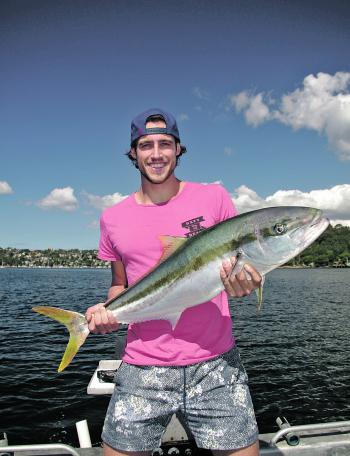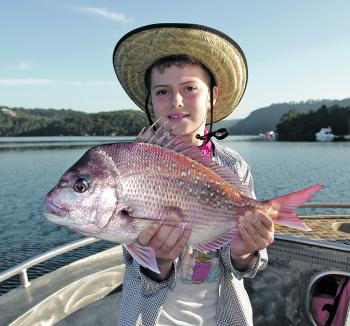It was a spectacular finish to the autumn season, thoroughly deserved after a woeful start. Up until March the water was just too warm and the fish didn’t like it. To be more accurate, the local fish didn’t like it, but we saw great tropical ring-ins like rainbow runner, cobia and a couple of varieties of northern trevally as compensation.
Hairtail also made a big appearance, with plagues of them showing up in November, and they’re still on the bite. They are a weird critter, normally associated with bitterly cold night sessions in the middle of winter on the Hawkesbury. Their daylight bites helped dispel some of the misconceptions about this species, the main one being that they swim around vertically. They don’t, they swim horizontally like most fish. We witnessed lots of them free swimming and chasing retrieved baits and lures in clear water and broad daylight.
It is true that hairtail swim backwards and vertically when hooked though, serpentining away from the angler, and this would have given rise to the myth that they naturally swim in the vertical attitude.
Hairtail are great eating, and the market price has been driven up to $60/kg – reflections of the Sydney property market.
Some big kings have come into Middle Harbour, as they did at this time last year. We have been pulling kings over a metre mixed in with some better than average amberjack. Last year these kings stayed right through winter, so fingers crossed for a repeat. You must get some fresh squid if you plan to chase them.
Offshore, Sydney had a better than average snapper season this year, and there has been a bit of spill over into the harbour. There have been nice pan-sized fish around the lower reaches and we even picked up a little humpy on a deep reef in Middle Harbour. They also like fresh squid baits and are best fished for around first light.
The good fishing should continue into June as the warm water is still well south of Sydney, and will take some time to retreat.
The use of downriggers has increased in popularity dramatically over the last few seasons. From what I am seeing on the harbour, most fishos have misinterpreted its purpose. When it comes to finding fish like kingies, a downrigger combined with a GPS, a good colour sounder and a live squid is the most effective tool available. You can cover a lot of ground with your bait presented at the right depth.
All in all though, it’s a poor fishing technique. It’s loud, cumbersome and clumsy. The wire sings in the water, there’s slack line after the strike, time is wasted setting up again after a strike and it’s usually limited to two rigs. The possibility of tangling the wire round the prop and having to stop the boat and retrieve the weight while dealing with the hooked fish at the same time – unless you have a very expensive electric retrieve downrigger – is really a two-man job.
As I said, it’s a top fish finding technique and all the drawbacks are justified when it’s used for this purpose. Unfortunately, this is not what I am seeing it being used for on the harbour. I’ll give you an example of what I have witnessed at least a dozen times this season.
I’ll be anchored on structure that I know to be holding fish, because we are catching them. The downrigging brigade become alerted to the fact that fish are sitting on the structure. Within 15 minutes there will be anywhere from one to six boats circling my boat, easily within casting distance (believe me – I’ve been tempted), like bandits around a wagon train. I’ve had them pick up both my anchor rope and my bait lines.
The wire noise, commotion and boat shadow of even two boats continuously downrigging a specific area will shut the fish down quick time. In the end, everyone loses. I am hearing similar complaints from other guides on the harbour and old time locals on Pittwater, so this is not just limited to my experience.
The problem is exacerbated by the fact that some of the offshore guides are doing it. They downrig all day offshore and have a quick prospect around some of the structures in the harbour on their way home to the boat ramp. Downrigging works well offshore in deep water where the ‘big blue’ absorbs a lot of the noise, boat shadow and general clatter. You can downrig in circles out wide and get away with it. It’s naive though to think that half a dozen big boats doing circles around the Wedding Cakes, with two noisy downriggers, in 30ft of water, are not going to put the fish off. The punters see them pull a couple of fish and, well – monkey see, monkey do. Now everyone is doing it.
There are some scenarios where downrigging in the harbour is appropriate and effective, however. For example, following the contours off the headlands works well. Likewise, moving from structure to structure in Middle Harbour is a great way of finding out which ones are holding fish. I’m not saying that a downrigger doesn’t have its place in the harbour, you just need to know when to pack it away and put the anchor down, spot lock or drift if conditions are appropriate.
So, here’s the rap. Downrigging in the harbour is a great fish finding technique, but a poor and even detrimental method for fishing once the fish are located. When you have found the fish, drop the anchor, retrieve the downrigger and fish straight under your boat as normal. If you keep hauling that wire and bomb through a school you will shut them down. Your moving boat shadow and engine noise are contributory.
Kings don’t mind a bit of commotion and are sometimes even attracted by it, but they’re not going to tolerate it for more than a couple of minutes. If you decide to go against my advice, that’s your choice. At least have the courtesy to keep plenty of distance between yourself and the boats that are doing the right thing. I’m talking at least 30m, but preferably 2km.
Thankyou in advance for your consideration.
Reads: 3959
Jordan Stenmark with a cracker Middle Harbour king.

A rare but welcome Middle Harbour snapper.

Middle Harbour is fishing well for amberjack.

Freya with a daytime hairtail.




